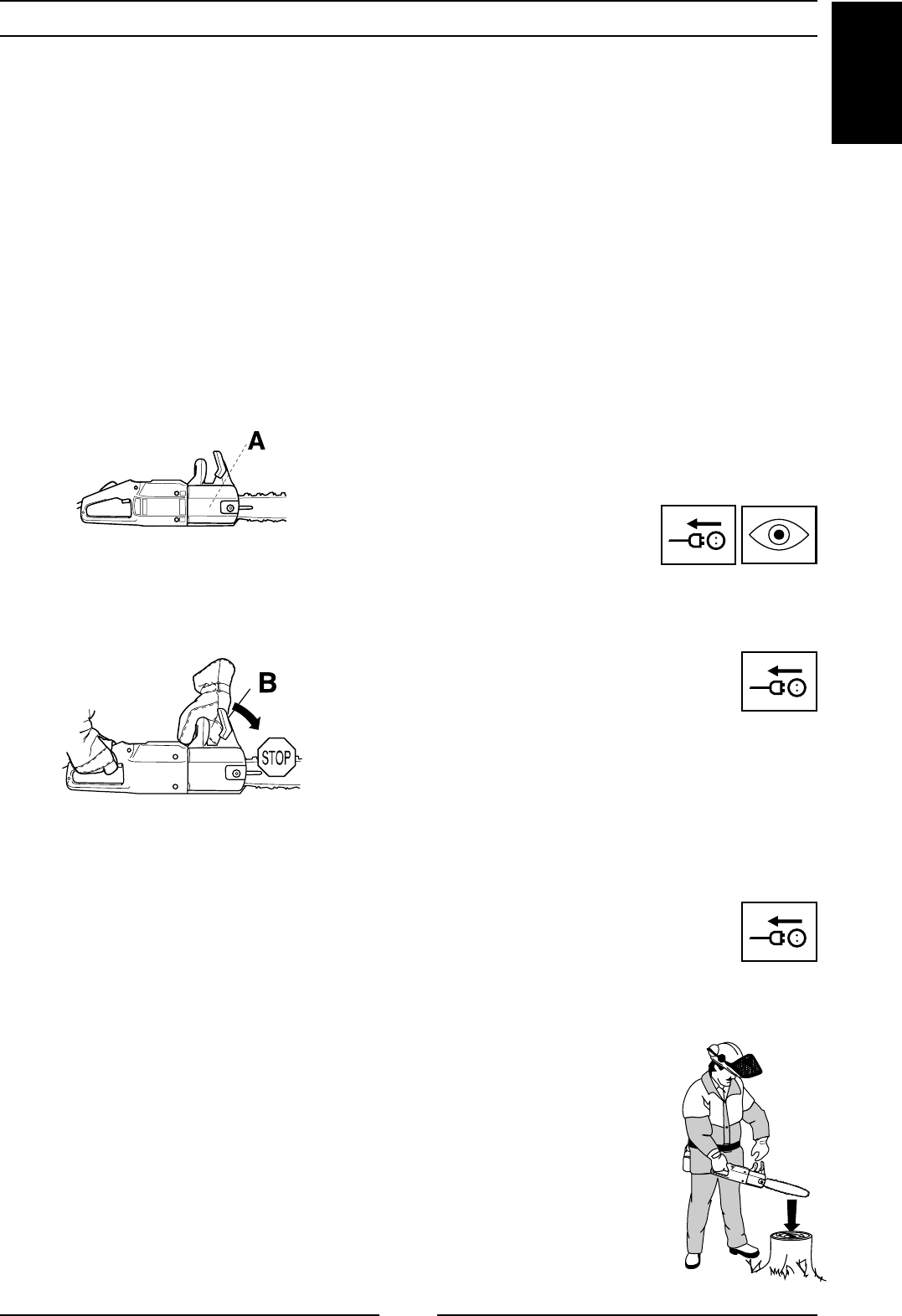
ENGLISH
9
• The chain brake may be activated manually or by the force
of inertia depending on the strength of the kickback and
the position of the saw in relation to the object which made
contact with the kickback danger zone.
- If the kickback is suffi ciently violent and the left hand
is too far from the kickback guard, the chain brake is
activated by the INERTIA of the chain brake against the
force of the kickback.
- In the event of smaller kickbacks or when the left hand
is near the kickback guard, the chain brake is activated
manually with the left hand.
• When the chain saw is turned on its side and the operator
is holding the side of the front handle, the kickback guard
will not strike the left hand in the event of a kickback and
will thus not activate the chain brake. In a situation of this
type, inertia is the only thing that can activate the chain
brake, but like manual activation, it will not work in every
situation.
Kickback guard inspection
• Inspect kickback guard for visible defects, such as cracks.
• Move kickback guard back and forth to ensure that it moves
freely without being loose.
Manual chain brake function check
• Check chain brake daily or every time the saw is used.
Holding the running saw fi rmly with the left hand on the
front handle and the right hand on the rear handle, twist
your left wrist, pushing the kickback guard to activate the
chain brake without letting go of the front handle. The chain
should stop instantaneously. If the chain brake does not
perform as required, have it serviced by authorized per-
sonnel.
Inertia chain brake function check
• Hold the running saw level with the guide bar approximately
45 cm above a stump or other solid wooden object.
Release the power trigger.
• Release the front handle, letting
the chain saw pivot in your
right hand as the guide bar falls
down and strikes the stump.
The brake should activate when
the bar nose hits the stump.
Your chain saw is equipped with a chain brake designed to
stop the chain instantaneously in the event of a kickback.
A chain brake can reduce the risk of accident, but only the
operator can prevent accidents from happening. Be extremely
careful when operating a chain saw and do not allow the kick-
back danger zone to make contact with anything.
• The chain brake (A) is activated either manually (with the left
hand) or by the force of inertia (the inertia of the kickback
guard resisting the motion of the saw from the force of the
kickback). However it is activated, the kickback protection
mechanism works in the opposite direction to the force of
the kickback. The saw incorporates a slip clutch which pro-
tects the saw against overload. If the chain stops while the
motor is running, the saw is overloaded. Ease up on the
cutting pressure until the chain starts running again. If the
saw jams in the tree, stop the saw immediately and free it.
• The chain brake is also activated when the kickback guard
(B) is pushed forward. This releases a springloaded mecha-
nism which jerks the brake band tightly around the brake
drum.
• The purpose of the kickback guard is not only to activate
the chain brake. Its other important function is to reduce
the danger of contact with the chain in the event that the
operator loses his grip on the front handle.
• Use the chain brake as a «parking brake» when carrying
the chain saw around or putting it down for short periods!
Besides automatic activation in the event of a kickback, the
chain brake may also be activated manually and must be
activated in the event of any inadvertent contact with a ro-
tating chain.
• An activated chain brake is released by pulling the kickback
guard back towards the front handle.
• As pointed out on page 7, a kickback can be extremely
violent and lightning-fast. Most kickbacks are small and do
not activate the chain brake. When this happens, it is im-
portant to maintain a fi rm grip on the saw and not let go.
CHAIN BRAKE WITH KICKBACK GUARD


















